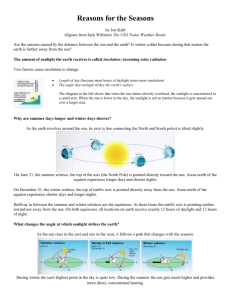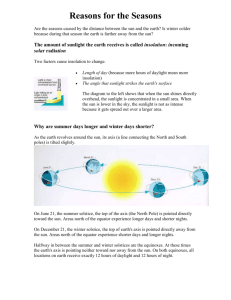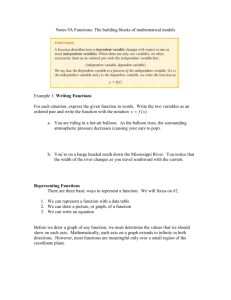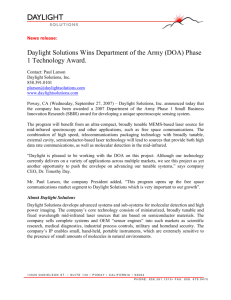Planning Customer Guidelines on Daylight and Sunlight
advertisement
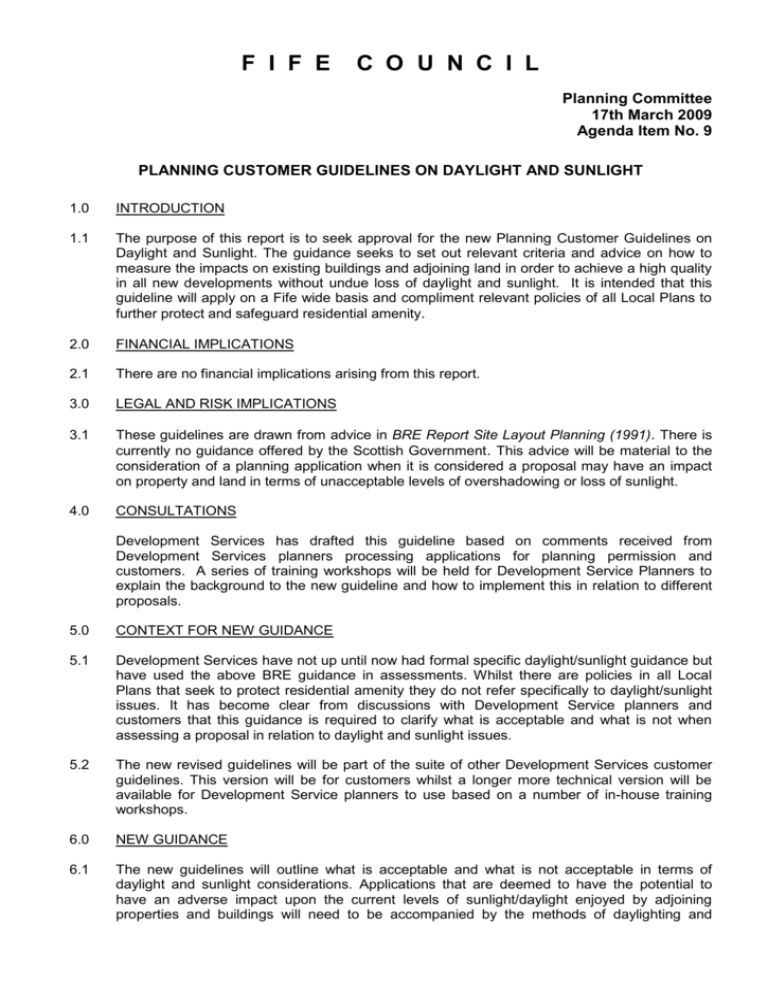
F I F E C O U N C I L Planning Committee 17th March 2009 Agenda Item No. 9 PLANNING CUSTOMER GUIDELINES ON DAYLIGHT AND SUNLIGHT 1.0 INTRODUCTION 1.1 The purpose of this report is to seek approval for the new Planning Customer Guidelines on Daylight and Sunlight. The guidance seeks to set out relevant criteria and advice on how to measure the impacts on existing buildings and adjoining land in order to achieve a high quality in all new developments without undue loss of daylight and sunlight. It is intended that this guideline will apply on a Fife wide basis and compliment relevant policies of all Local Plans to further protect and safeguard residential amenity. 2.0 FINANCIAL IMPLICATIONS 2.1 There are no financial implications arising from this report. 3.0 LEGAL AND RISK IMPLICATIONS 3.1 These guidelines are drawn from advice in BRE Report Site Layout Planning (1991). There is currently no guidance offered by the Scottish Government. This advice will be material to the consideration of a planning application when it is considered a proposal may have an impact on property and land in terms of unacceptable levels of overshadowing or loss of sunlight. 4.0 CONSULTATIONS Development Services has drafted this guideline based on comments received from Development Services planners processing applications for planning permission and customers. A series of training workshops will be held for Development Service Planners to explain the background to the new guideline and how to implement this in relation to different proposals. 5.0 CONTEXT FOR NEW GUIDANCE 5.1 Development Services have not up until now had formal specific daylight/sunlight guidance but have used the above BRE guidance in assessments. Whilst there are policies in all Local Plans that seek to protect residential amenity they do not refer specifically to daylight/sunlight issues. It has become clear from discussions with Development Service planners and customers that this guidance is required to clarify what is acceptable and what is not when assessing a proposal in relation to daylight and sunlight issues. 5.2 The new revised guidelines will be part of the suite of other Development Services customer guidelines. This version will be for customers whilst a longer more technical version will be available for Development Service planners to use based on a number of in-house training workshops. 6.0 NEW GUIDANCE 6.1 The new guidelines will outline what is acceptable and what is not acceptable in terms of daylight and sunlight considerations. Applications that are deemed to have the potential to have an adverse impact upon the current levels of sunlight/daylight enjoyed by adjoining properties and buildings will need to be accompanied by the methods of daylighting and sunlighting assessment set out in the BRE Report Site Layout Planning and where appropriate demonstrate both ‘before’ and ‘after’ circumstances. The guidelines address the following: The main differences between daylight and sunlight The guidance explains the main differences between daylight and sunlight by highlighting a number of important facts that need to be taken into account when considering daylight/sunlight issues in relation to development proposal. When to consider daylighting/sunlighting issues The guidelines set out a number of factors that need to be taken into account when considering a proposal in relation to daylighting/sunlighting issues. Methods to ensure that adequate daylight is achieved and undue overshadowing does not occur The guidance seeks to highlight and clearly explain the main differences between three methods of calculating daylight and sunlight in relation to a new development. The guidance advocates that the design of residential environments must seek to ensure that adequate levels of natural light can be achieved within new dwellings and unacceptable impacts on light to nearby properties are minimised or preferably avoided. 7.0 CONCLUSIONS 7.1 The purpose of this new planning customer guideline is to help both Council staff and customers make decisions when assessing a planning application or putting together a proposed development. The guideline is intended to help support current local plan policy on residential amenity and provide specific guidance so that quality development is achieved without compromise. 8.0 RECOMMENDATIONS 8.1 It is recommended that Members: Adopt the new planning customer guidelines detailed above on daylight and sunlight. Note that a published version will be made available to customers in the standard format for Planning Customer Guidelines. Keith Winter Head of Development Services Jim Birrell Development Manager (Development and Regeneration) Fife House North Street Glenrothes Author: Mark R Russell and Sarah Johnston 08451 555 555 ext. 473835 Date: February 2008 BACKGROUND PAPERS Under Section 50(d) of the Local Government (Scotland) Act 1973 the following background papers were relied upon in the preparation of this report: BRE Report Site Layout Planning New Planning guidelines on daylight/sunlight Appendix 1 Daylight and Sunlight Guidance Introduction This guidance sets out the relevant criteria and advice how to measure the impacts on existing buildings and adjoining land in order to achieve a high quality in all new developments. This has been based on Building Research Establishment Report Site Layout for Daylight and Sunlight: A Guide to Good Practice by P J Littlefair (1991). Each application will be assessed on its merits. What does this guidance cover? This guideline is applied on a Fife wide basis and relates to all new development including extensions to existing buildings and changes of use. This guidance seeks to complement relevant policies of all Local Plans to further protect and safeguard residential amenity. Applications that are deemed to have the potential to have an adverse impact upon the current levels of sunlight/daylight enjoyed by adjoining properties and buildings will need to be accompanied by the methods of daylighting and sunlighting assessment set out in the BRE Report Site Layout Planning and where appropriate demonstrate both ‘before’ and ‘after’ circumstances. Sunlight/daylight-What are the main differences? Daylight is defined as being the volume of natural light that enters a building to provide satisfactory illumination of internal accommodation between sun rise and sunset. This can be known as ambient light. Sunlight refers to direct sunshine. Below are some helpful hints to take into account: The sun rises in the east and sets in the west. The sun reaches its maximum height around noon and will generally be due south at this time. The sun is higher in the sky in summer months as opposed to winter months. The sun elevation in mid-winter does not generally rise above 10 degrees in Scotland and therefore can cast long shadows. When do I need to consider daylight/overshadowing issues? Before submitting your planning application (check first that planning permission is required in the first instance) you should contact Development Services to check whether a daylighting/overshadowing assessment is required. The Council will require as a minimum that: All new development including extensions overshadowing of neighbouring properties. will be designed to minimise The greater part of any overshadowing that occurs will be confined to applicants own land. There are a number of major factors that have to be taken into account in any assessment. These are as follows: Height; Distance to boundaries; Size of Plot; Orientation; and Topography The Council will not support extensions or any new development that would result in the loss of sunlight leading to overshadowing for the majority of the day. Whilst a building warrant will ensure that there is a minimum level of daylighting, all buildings including changes of use and extensions/new developments will still be required to provide adequate levels of sunlight. A building warrant is no guarantee that planning permission will be granted. The 45 Degree rule of thumb At all times care should be taken in the design of residential environments to ensure that adequate levels of natural light (based on Building Standards) can be achieved within new dwellings and unacceptable impacts on light to nearby properties are minimised and preferably avoided. Proposed dwellings should be laid out so as to maximise the penetration of sunlight to main rooms and gardens. The overshadowing of amenity spaces, particularly those that are used for outdoor seating should be minimised. The Building Research Establishment (BRE) guidelines “Site Layout Planning for Daylight and Sunlight: A Guide to Good Practice” (1991) provides guidance on avoiding unacceptable impacts and sets out non-mandatory targets for levels of daylight and sunlight within existing and proposed development. The Council will generally apply the BRE guidance targets where new development affects natural light to existing properties. A useful guideline to measuring the impact of the new development is the 45 degree rule of thumb method as can be seen in Diagram 1 below. Diagram 1 New flatted housing layouts in the form of ‘T’ shaped plans (i.e. projection to rear elevation), courts or quadrangles, projecting wing arrangements (on side or end elevations), house designs with projections and angled frontages, and house extensions which adjoin the front or rear of a house are required to satisfy the 45 degree assessment method. Application of the 45° approach to domestic extensions is summarised in Diagram 1 above. A significant amount of light is likely to be blocked if the centre of the window (or for a floorto- ceiling window, as here, a point two metres form the ground) lies within the 45° lines of both plan and elevation. The method applies only where the nearest side of the extension is at a right angle to the window and not for windows which directly face it. The 45 degree method can also be applied to new house designs in situations where windows are placed at the corners of internal courtyards; ‘L’ or ‘T’ shaped or angled blocks. In all new residential development proposals where future extension(s) could cause serious loss of light to neighbouring property the Council will consider removing permitted development rights. 25 Degree Rule of Thumb This approach should be used when the new development directly faces the affected window. Suitable daylight for habitable rooms is achieved when a 25 degree vertical angle taken from the centre of the lowest windows is kept unobstructed. See diagram 2. The recommended distance between the buildings is dependent on the opposing property ridge height. If the building opposite has a high ridge, the loss of daylight will be more notable than if the building has a lower ridge height. If the proposed development fails this test and that of the 45 degree method then further investigation and evidence will be required by the Council in order to assess whether an unacceptable loss of sunlight/daylight will occur. Diagram 2 The Vertical Sky Component Method In cases where it is not possible to meet the criteria set out above and where a more detailed assessment is necessary, for example in areas of historic townscape, this should be made by calculating the vertical sky component. The methodology for calculating the vertical sky component is set out in more detail in the BRE report “Site Layout Planning” which also contains advice and guidance on interior daylighting standards. (This information should be submitted with the application). A satisfactory level of daylight is assessed by calculating the vertical sky component for neighbouring property whether existing or, when none exists, for possible development equal to the proposed. New development adjacent to vacant land should as a minimum requirement ensure that this land retains the potential for good diffuse daylighting. Sunlight All new development should seek in line with other policies and guidance to maximise the benefits of sunlight to provide a pleasant living environment and promote solar gain. How to contact us Development Services Forth House Abbotshall Road Kirkcaldy KY1 1RU Tel: 01592 583350 Email: development.central@fife.gov.uk Development Services County Buildings St Catherine Street Cupar KY15 4TB Tel: 01334 659334 Email: development.east@fife.gov.uk Development Services New City House 1 Edgar Street Dunfermline KY12 7EP Tel: 01383 609120 Email: development.west@fife.gov.uk


